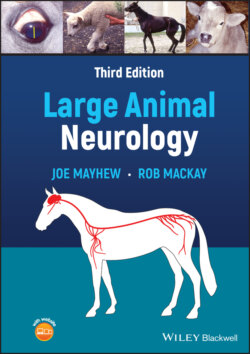Читать книгу Large Animal Neurology - Joe Mayhew - Страница 40
Vestibulocochlear nerve—CN VIII
ОглавлениеThe cochlear or auditory division of this nerve transmits impulses involved with hearing. Bilateral middle ear disease causes deafness, but unilateral hearing loss would be difficult or impossible to detect clinically in large animals without the use of auditory evoked potential recordings.
The vestibular division of CN VIII supplies the major input to the vestibular system (Figure 2.11), thereby controlling balance. Fibers from the inner ear pass through the internal acoustic meatus in the petrosal bone and penetrate the lateral medulla oblongata to terminate in the vestibular nuclei. A few fibers pass to small areas in the ventral cerebellum that are part of the vestibular system. The vestibular system receives input from the inner ear and functions by controlling orientation of the head, body, limbs, and eyes in space and with respect to gravity. Signs of vestibular disease can be seen with lesions involving any part of the vestibular system. The eyeballs are checked for normal vestibular nystagmus when the head is moved from side to side. The presence of spontaneous nystagmus seen with the head in a normal position, and positional nystagmus seen with the head held still in various abnormal positions, indicate a disorder of the vestibular system. In unilateral peripheral vestibular system disorders, the fast phase of any nystagmus is quite consistently directed away from the side of the lesion and away from the direction of the head tilt. It is usually horizontal, although it may be rotary or arc‐shaped. Only in a few horses with peracute signs of bilateral vestibular neuritis, histologically consistent with polyneuritis equi, transient, dorsally directed nystagmus has been observed with a peripheral—in this case bilateral—vestibular disorder. With lesions involving the central components of the vestibular system in the medulla oblongata, spontaneous and positional nystagmus may be horizontal, vertical or rotary, and may change direction with changes in head posture. Such lesions frequently affect adjacent structures, such as the proprioceptive and motor pathways for voluntary limb movement, and the reticular formation, resulting in ataxia and tetraparesis, and somnolence, respectively. Particularly with acute peripheral vestibular disease, signs often improve within several days because of accommodation, mediated by other inputs to the vestibular system including proprioceptive modalities and especially vision. By blindfolding a patient that has accommodated to its vestibular disease, signs frequently become exacerbated immediately. Additionally, blindness interferes with recovery from vestibular disease.
Figure 2.11 Vestibular system.
On rare occasions, central unilateral or asymmetric CNS lesions, particularly if in the region of the caudal cerebellar peduncle, may result in paradoxical vestibular signs. This is seen as any head tilt and circling being away from, and the fast phase of nystagmus being toward, the side of the lesion. Defining the side of such a lesion will depend on identifying other signs of cerebellar and/or medullary disease.
A rather forgotten component to the vestibular system is proprioceptive input from the cranial cervical vertebrae, ligaments, and muscles.23,24 From this region, afferent fibers pass via at least the C1–3 dorsal spinal nerve roots to ascend the spinal cord to the caudal part of the medial vestibular nuclei that receive no other afferent inputs (Figure 2.11).25 Like damage to the vestibular nerve, lesions involving these cervical nerves or the cervical spinal input to the vestibular apparatus can result in signs of vestibular disease. This certainly can be seen with asymmetric lesions of the dorsal nerve roots of C1–3 when loss of balance, eye deviation, and a head tilt can be seen.
